As a dog lover and owner, I know how important it is to provide our furry friends with a healthy and balanced diet. But when it comes to introducing new foods into their meals, we must exercise caution and ensure their safety. One such food that often raises questions is collard greens. Can dogs eat collard greens? Let’s explore the safety of collard greens for dogs and learn some important feeding tips to keep our pets healthy and happy.
Key Takeaways:
- Collard greens can be a nutritious addition to a dog’s diet, but it’s essential to consult with a veterinarian before feeding them to your dog.
- Collard greens are rich in vitamins A, C, and K, as well as folate and riboflavin, making them a healthy choice for dogs.
- When feeding collard greens to dogs, remove the tough stems and chop the leaves before incorporating them into your dog’s regular food.
- Dogs with bladder or kidney issues should avoid collard greens due to their high content of isothiocynates and calcium oxalate.
- It’s best to cook fresh collard greens at home and avoid canned varieties to ensure the safety and nutritional value of the food given to dogs.
Nutritional Benefits of Collard Greens for Dogs
Collard greens are incredibly beneficial for a dog’s overall health and well-being. They are packed with essential vitamins and minerals that contribute to a balanced and nutritious diet. Here are some of the key nutritional benefits of collard greens for dogs:
Vitamins
Collard greens are rich in vitamins A, C, and K, which play a crucial role in supporting a dog’s immune system, promoting healthy skin and coat, and aiding in blood clotting. These vitamins are essential for maintaining your dog’s overall health and vitality.
Minerals
In addition to vitamins, collard greens are also a great source of minerals such as folate and riboflavin. Folate is necessary for cell division and the production of new red blood cells, while riboflavin helps the body convert food into energy and supports healthy vision and skin.
Fiber
Collard greens are high in fiber, which is important for a dog’s digestive health. Fiber promotes regular bowel movements, helps prevent constipation, and aids in the absorption of nutrients from the diet. It also contributes to a feeling of fullness, which can be beneficial for dogs who need to manage their weight.
By incorporating collard greens into your dog’s diet, you can provide them with essential vitamins, minerals, and fiber, contributing to their overall health and well-being.
| Nutrient | Amount per 100g |
|---|---|
| Vitamin A | 3333 IU |
| Vitamin C | 35.3 mg |
| Vitamin K | 257.5 mcg |
| Folate | 61 mcg |
| Riboflavin | 0.15 mg |
| Fiber | 3.6 g |
How to Safely Feed Collard Greens to Dogs
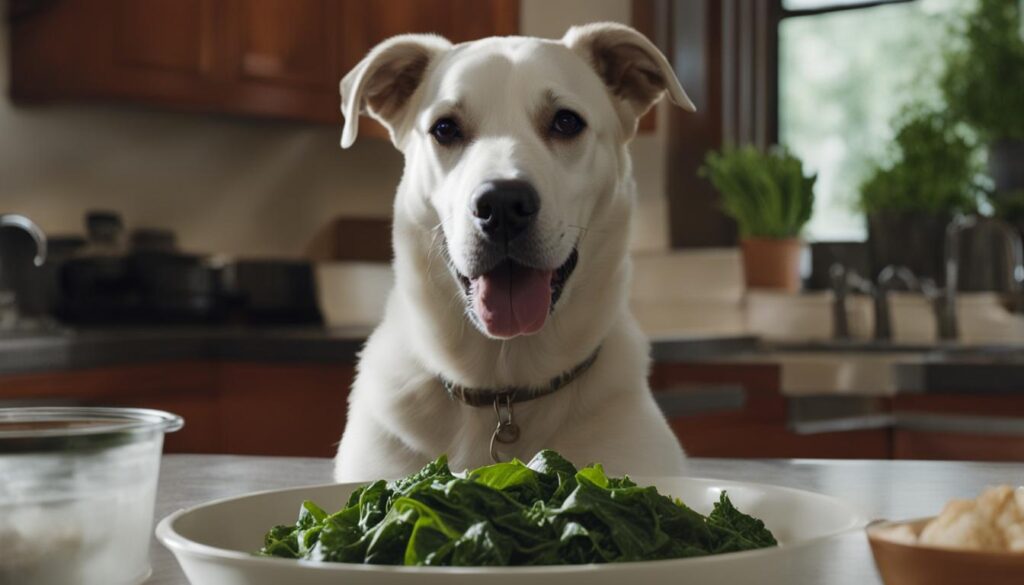
When it comes to feeding collard greens to our furry friends, safety and proper preparation are key. To ensure the well-being of your dog, follow these guidelines:
Serve Only the Leaves
It’s important to serve only the leaves of collard greens to dogs, avoiding the stems. The stems can be difficult for dogs to digest and may cause diarrhea. By removing the stems, you can minimize the risk of digestive issues and make the collard greens more dog-friendly.
Steam to Soften
Steaming the collard green leaves can help soften them, making them easier for dogs to chew and digest. Softening the leaves can also enhance the palatability, making it more likely that your dog will enjoy their meal.
Chop and Incorporate
Rather than offering collard greens as a standalone meal, it is recommended to chop the leaves and incorporate them into your dog’s regular food. This ensures a balanced and healthy diet for your furry companion, while also making it easier for them to consume the collard greens.
Remember, always consult with your veterinarian to determine the appropriate portion size and frequency of feeding collard greens to your dog, based on their size, breed, and specific dietary needs.
| Benefits of Safely Feeding Collard Greens to Dogs | How to Safely Feed Collard Greens to Dogs |
|---|---|
|
|
Risks of Feeding Collard Greens to Dogs
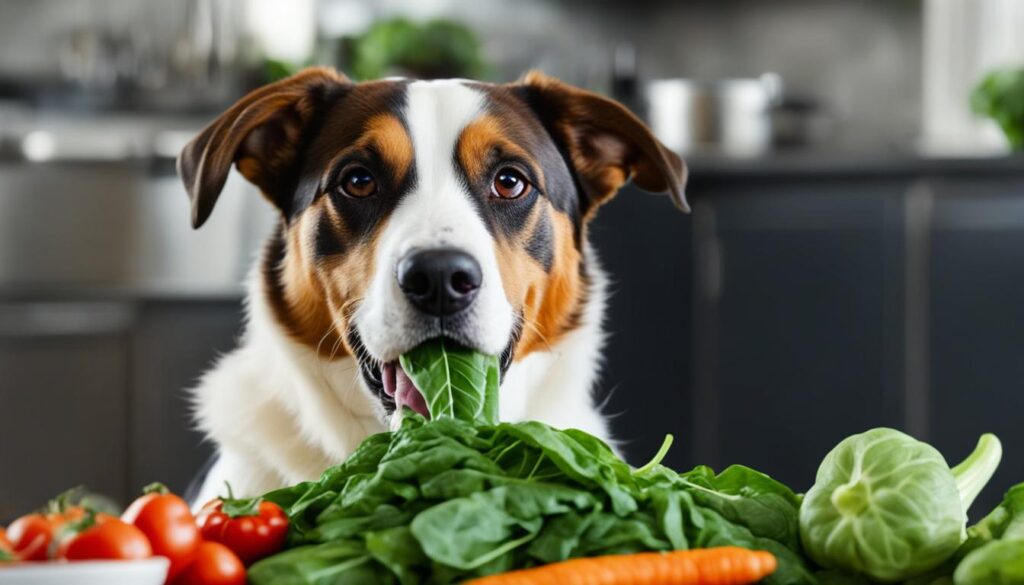
While collard greens are generally safe for dogs, it’s important to be aware of potential risks associated with their consumption. Collard greens contain substances called isothiocynates and calcium oxalate, which can increase the risk of bladder and kidney stones in dogs. Dogs with pre-existing bladder or kidney issues should exercise caution and avoid collard greens to prevent further complications.
Additionally, serving collard greens in excessive amounts or without proper preparation can lead to digestive issues such as diarrhea and stomach aches. It’s crucial to feed collard greens to dogs in moderation and ensure they are properly cooked and served.
Consulting with a veterinarian is highly recommended before introducing collard greens or any new food into your dog’s diet. They can provide guidance based on your dog’s specific health needs and dietary requirements.
Foods that are Toxic for Dogs
| Foods | Toxicity Level |
|---|---|
| Chocolate | Highly Toxic |
| Grapes and Raisins | Potentially Toxic |
| Onions and Garlic | Potentially Toxic |
| Avocado | Potentially Toxic |
| Xylitol (Artificial Sweetener) | Highly Toxic |
Remember, ensuring the safety and well-being of your dog is paramount when it comes to their nutrition. Always prioritize their health by avoiding potentially toxic foods and seeking professional advice before introducing any unfamiliar ingredients into their diet.
Can Dogs Eat Collard Greens Raw?
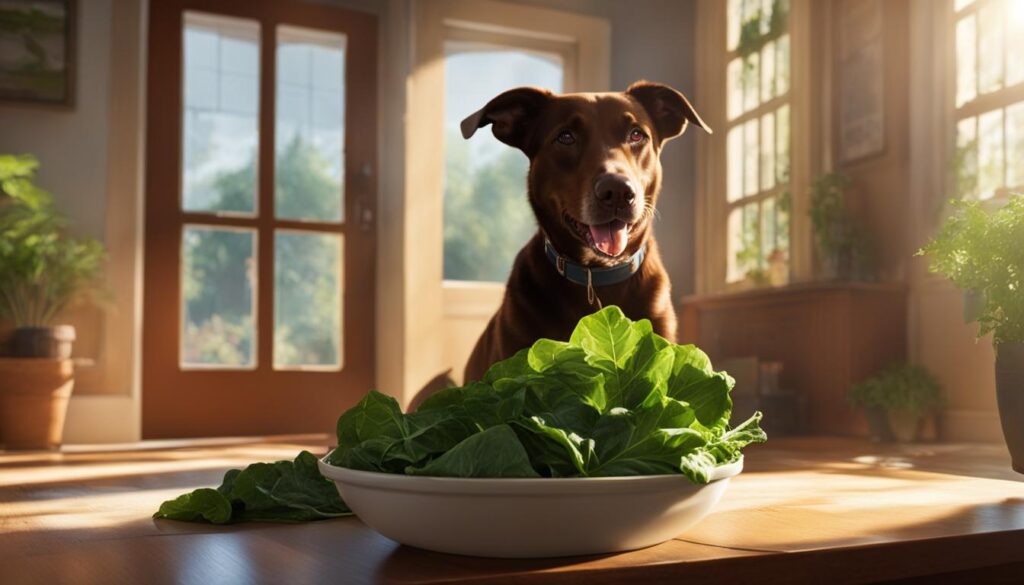
Dogs should not eat raw collard greens as they are tough and difficult to digest. Raw collard greens can cause stomach upset and may lead to gastrointestinal issues. It is recommended to cook collard greens before feeding them to your dog to make them more palatable and easier to digest.
Raw collard greens can be challenging for dogs to chew and break down, potentially causing discomfort and digestive problems. Cooking collard greens softens their texture and makes them more suitable for canine consumption. The process of cooking breaks down the fibrous structure of the greens, making them easier to chew and digest. By cooking collard greens, you can enhance their palatability for your dog while also ensuring their safety.
When cooking collard greens for your dog, it is important to avoid adding any harmful ingredients such as garlic or onions, which can be toxic to dogs. Stick to simple cooking methods such as boiling or steaming, as these processes retain the nutritional value of the greens while making them more digestible. Ensure that the collard greens are thoroughly cooked to a soft consistency to prevent any potential digestive issues.
Feeding cooked collard greens to your dog conveys multiple benefits. Firstly, it eliminates the potential digestive problems that raw greens may cause. Additionally, cooking collard greens enhances their taste, making them more appealing to your canine companion. By incorporating cooked collard greens into your dog’s meals, you can provide them with a healthy and nutrient-rich addition to their diet.
Potential Benefits of Collard Greens for Dogs
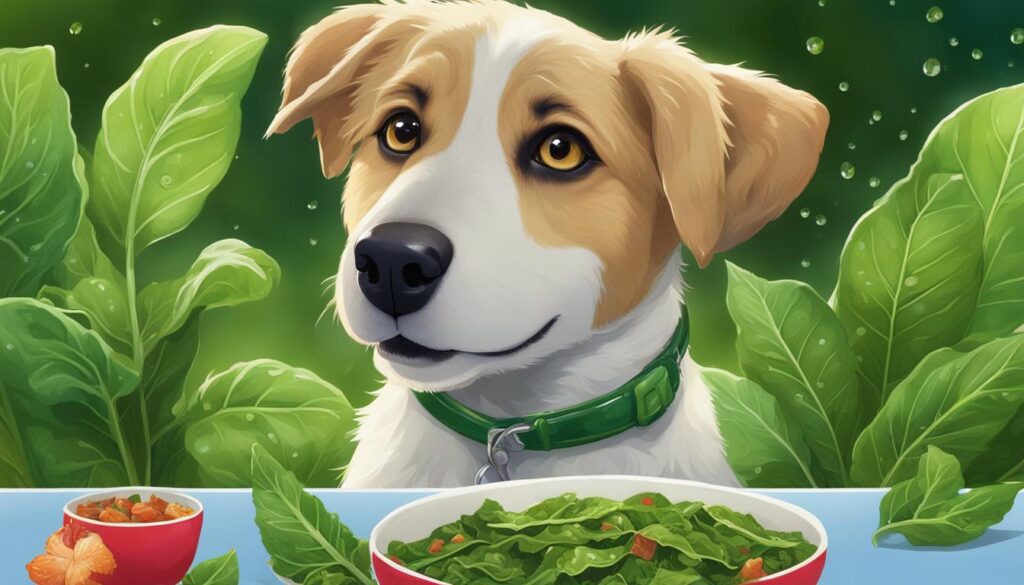
While collard greens should be fed in moderation and with caution, they can provide several health benefits for dogs. The vitamins and minerals found in collard greens, such as vitamin K, folate, and fiber, can support a dog’s overall health and well-being. They can also contribute to a balanced and nutritious diet for dogs.
Collard greens are packed with essential nutrients that can promote a dog’s optimal health. Here are some potential benefits of including collard greens in your dog’s diet:
- Improved Digestion: The high fiber content in collard greens can aid in digestive health and promote regular bowel movements in dogs. This can help prevent constipation and other digestive issues.
- Healthy Weight Management: Collard greens are low in calories and can be a great addition to a weight management plan for overweight or obese dogs. Their high fiber content can help dogs feel full and satisfied without consuming excessive calories.
- Boosted Immune System: The vitamins and minerals found in collard greens, such as vitamin A and C, can help strengthen a dog’s immune system and protect against common illnesses and infections.
- Joint Health: Collard greens contain natural anti-inflammatory compounds, such as vitamin K, which can help reduce inflammation and promote joint health in dogs, especially those with arthritis or joint-related issues.
- Healthy Skin and Coat: The vitamins and minerals in collard greens, such as folate and vitamin E, can contribute to a dog’s healthy skin and coat. They can help improve skin texture, reduce dryness, and promote a shiny, lustrous coat.
However, it is important to note that every dog is different, and not all dogs may benefit from collard greens. Some dogs may have specific dietary restrictions or health conditions that may contraindicate the consumption of collard greens. It is always recommended to consult with your veterinarian before making any changes to your dog’s diet.
Recommended Daily Serving of Collard Greens for Dogs
The appropriate serving size of collard greens for dogs depends on their individual dietary needs, size, and overall health. As a general guideline, it is recommended to feed collard greens in moderation and include them as part of a balanced diet. Here is a table outlining the recommended daily serving sizes of collard greens for different weight ranges of dogs:
| Weight Range | Recommended Daily Serving of Collard Greens |
|---|---|
| Small Dogs (up to 20 pounds) | 1/4 to 1/2 cup |
| Medium Dogs (20 to 50 pounds) | 1/2 to 1 cup |
| Large Dogs (50 to 80 pounds) | 1 to 2 cups |
| Giant Dogs (80 pounds and above) | 2 to 3 cups |
It is essential to remember that these serving sizes are general recommendations and may vary depending on the specific needs and dietary requirements of your dog. Always monitor your dog’s weight, overall health, and consult with your veterinarian to determine the appropriate serving size.
Recommended Serving Sizes for Dogs
The appropriate serving size of collard greens for dogs depends on their size and individual dietary needs. As a general guideline, it is recommended to serve less than half a cup of collard greens per day for dogs. However, it is crucial to consult with your veterinarian to determine the exact serving size that is appropriate for your dog.
Cooking Methods for Collard Greens for Dogs
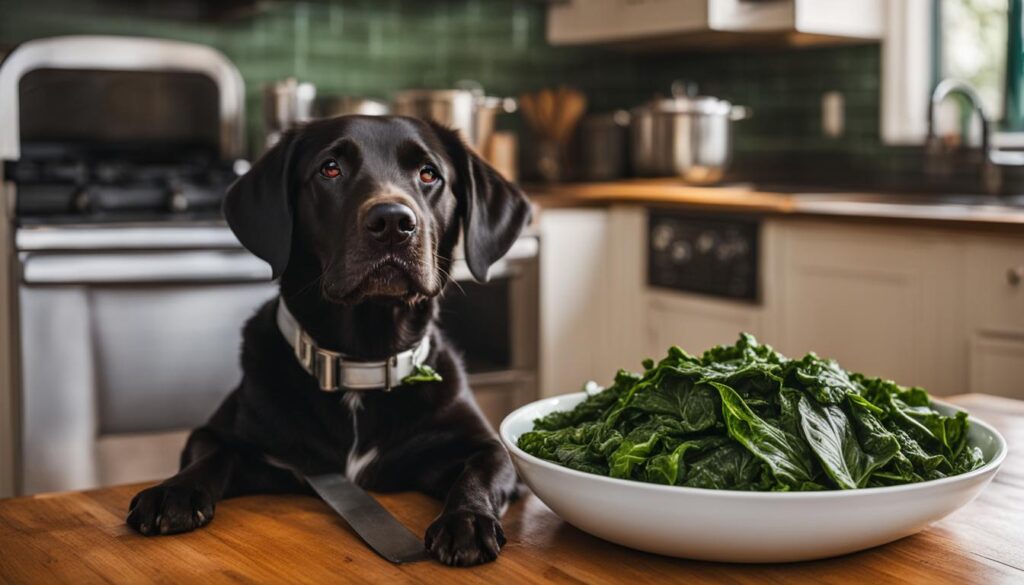
When it comes to preparing collard greens for dogs, ensuring their safety and nutritional value is crucial. While collard greens can be a beneficial addition to a dog’s diet, it is important to use the right cooking methods and avoid any toxic ingredients.
The safest cooking methods for collard greens that are dog-friendly include sautéing or steaming them without adding any salt. These methods help to preserve the nutrients while making the leaves soft and easily digestible for dogs. It is also essential to remove the tough stems before cooking to ensure a pleasant texture.
Cooked collard greens provide dogs with essential vitamins, minerals, and fiber, contributing to their overall health and well-being. By following these cooking guidelines, you can incorporate collard greens into your dog’s diet safely and provide them with a healthy and nutritious meal.
Collard greens cooked using dog-friendly methods are an excellent addition to a nutritious and balanced diet for dogs, offering a range of health benefits. Remember to consult with your veterinarian for personalized feeding advice and guidance on incorporating collard greens into your dog’s diet.
Caution with Canned Collard Greens for Dogs
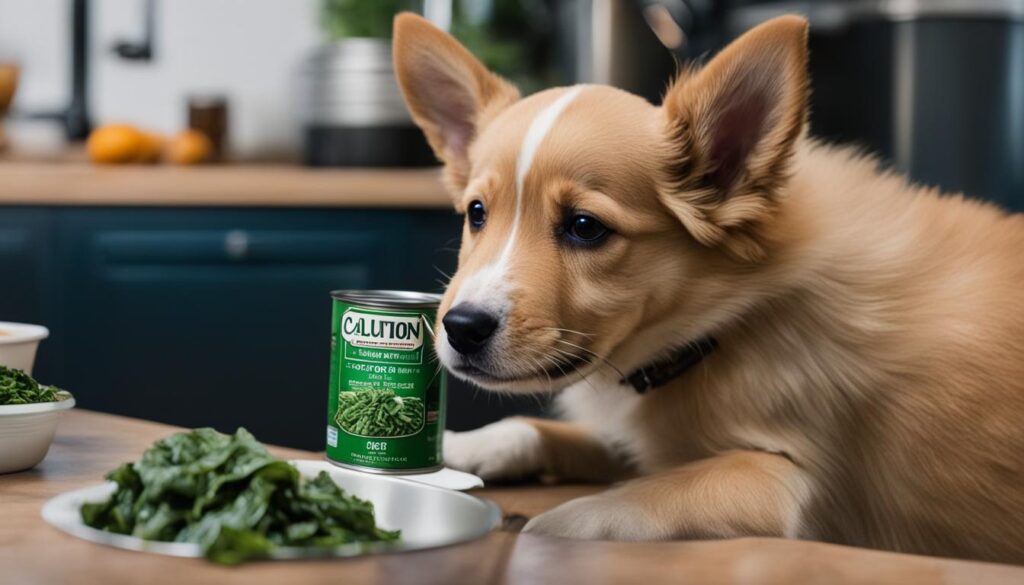
Dogs should not consume canned collard greens as they may contain excessive salt and preservatives, which can be harmful to dogs. It is best to cook fresh collard greens at home and avoid canned varieties to ensure the safety and nutritional value of the food given to dogs.
| Canned Collard Greens | Concerns |
|---|---|
| High salt content | Excessive salt can lead to sodium toxicosis in dogs and cause symptoms such as vomiting, diarrhea, and increased thirst. |
| Preservatives | Artificial preservatives in canned collard greens can be harmful to dogs and may cause digestive issues or allergic reactions. |
| Lack of nutrients | Canned collard greens may have lower nutritional value compared to fresh ones, as the canning process can degrade some of the essential vitamins and minerals. |
By cooking fresh collard greens at home, you have better control over the ingredients and can ensure that the food you provide to your furry friend is safe and beneficial. Fresh collard greens retain their nutritional value and are free from unnecessary additives that may pose risks to your dog’s health.
Wrapping Up
In conclusion, dogs can eat collard greens as part of a balanced and healthy diet. Collard greens offer numerous health benefits, as they are packed with essential vitamins and minerals such as vitamins A, C, and K, folate, and fiber. However, it’s crucial to feed collard greens to dogs in moderation and take certain precautions.
Before introducing collard greens to your dog’s diet, it’s important to consult with a veterinarian. They will be able to assess your dog’s specific nutritional needs and advise on the appropriate serving size. Additionally, dogs with bladder or kidney issues should avoid collard greens due to their high content of isothiocyanates and calcium oxalate.
When preparing collard greens for your dog, make sure to remove the tough stems and cook the leaves until they are soft and easily chewable. Steaming or sautéing without added salt is recommended. It’s essential to avoid using canned collard greens, as they may contain harmful additives and excessive salt.
In summary, while dogs can have collard greens, it’s important to feed them in moderation, prepare them properly, and consult with a veterinarian to ensure they are safe and beneficial for your furry friend.
FAQ
Can dogs eat collard greens?
Yes, collard greens can be a nutritious addition to a dog’s diet. However, there are some important factors to consider before feeding them to your furry friend.
What are the nutritional benefits of collard greens for dogs?
Collard greens are rich in vitamins A, C, and K, as well as folate and riboflavin. They are also high in fiber, which can promote regular digestion in dogs.
How can I safely feed collard greens to my dog?
It is important to serve only the leaves of collard greens and avoid the stems. Steaming the leaves can help soften them and make them easier for dogs to consume. It is also recommended to chop the leaves and incorporate them into your dog’s regular food.
Are there any risks associated with feeding collard greens to dogs?
Collard greens can potentially cause bladder and kidney stones in dogs with bladder or kidney issues due to their high content of isothiocynates and calcium oxalate. It is important to exercise caution and consult with your veterinarian before feeding collard greens to your dog.
Can dogs eat collard greens raw?
It is not recommended to feed dogs raw collard greens as they are tough and difficult to digest. Raw collard greens can cause stomach upset and gastrointestinal issues in dogs.
What are the potential benefits of collard greens for dogs?
The vitamins and minerals found in collard greens can support a dog’s overall health and well-being. They can contribute to a balanced and nutritious diet for dogs.
What is the recommended serving size of collard greens for dogs?
The appropriate serving size of collard greens for dogs depends on their size and individual dietary needs. It is important to consult with your veterinarian to determine the exact serving size that is appropriate for your dog.
How should I cook collard greens for dogs?
It is important to avoid adding any toxic ingredients such as garlic or onions when cooking collard greens for dogs. The safest cooking methods include sautéing or steaming the leaves without any added salt.
Can dogs eat canned collard greens?
Dogs should not consume canned collard greens as they may contain excessive salt and preservatives, which can be harmful to dogs. It is best to cook fresh collard greens at home to ensure the safety and nutritional value of the food.
Can dogs have collard greens?
While collard greens can be a nutritious addition to a dog’s diet, it is important to feed them in moderation and consult with a veterinarian beforehand.






